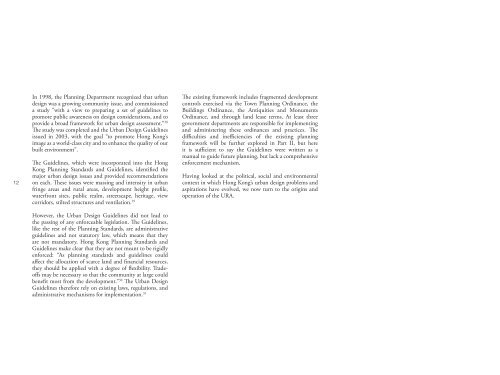Treating the Symptoms - A Critical Review of ... - Civic Exchange
Treating the Symptoms - A Critical Review of ... - Civic Exchange
Treating the Symptoms - A Critical Review of ... - Civic Exchange
- No tags were found...
Create successful ePaper yourself
Turn your PDF publications into a flip-book with our unique Google optimized e-Paper software.
12In 1998, <strong>the</strong> Planning Department recognized that urbandesign was a growing community issue, and commissioneda study “with a view to preparing a set <strong>of</strong> guidelines topromote public awareness on design considerations, and toprovide a broad framework for urban design assessment.” 28The study was completed and <strong>the</strong> Urban Design Guidelinesissued in 2003, with <strong>the</strong> goal “to promote Hong Kong’simage as a world-class city and to enhance <strong>the</strong> quality <strong>of</strong> ourbuilt environment”.The Guidelines, which were incorporated into <strong>the</strong> HongKong Planning Standards and Guidelines, identified <strong>the</strong>major urban design issues and provided recommendationson each. These issues were massing and intensity in urbanfringe areas and rural areas, development height pr<strong>of</strong>ile,waterfront sites, public realm, streetscape, heritage, viewcorridors, stilted structures and ventilation. 29However, <strong>the</strong> Urban Design Guidelines did not lead to<strong>the</strong> passing <strong>of</strong> any enforceable legislation. The Guidelines,like <strong>the</strong> rest <strong>of</strong> <strong>the</strong> Planning Standards, are administrativeguidelines and not statutory law, which means that <strong>the</strong>yare not mandatory. Hong Kong Planning Standards andGuidelines make clear that <strong>the</strong>y are not meant to be rigidlyenforced: “As planning standards and guidelines couldaffect <strong>the</strong> allocation <strong>of</strong> scarce land and financial resources,<strong>the</strong>y should be applied with a degree <strong>of</strong> flexibility. Trade<strong>of</strong>fsmay be necessary so that <strong>the</strong> community at large couldbenefit most from <strong>the</strong> development.” 30 The Urban DesignGuidelines <strong>the</strong>refore rely on existing laws, regulations, andadministrative mechanisms for implementation. 31The existing framework includes fragmented developmentcontrols exercised via <strong>the</strong> Town Planning Ordinance, <strong>the</strong>Buildings Ordinance, <strong>the</strong> Antiquities and MonumentsOrdinance, and through land lease terms. At least threegovernment departments are responsible for implementingand administering <strong>the</strong>se ordinances and practices. Thedifficulties and inefficiencies <strong>of</strong> <strong>the</strong> existing planningframework will be fur<strong>the</strong>r explored in Part II, but hereit is sufficient to say <strong>the</strong> Guidelines were written as amanual to guide future planning, but lack a comprehensiveenforcement mechanism.Having looked at <strong>the</strong> political, social and environmentalcontext in which Hong Kong’s urban design problems andaspirations have evolved, we now turn to <strong>the</strong> origins andoperation <strong>of</strong> <strong>the</strong> URA.
















